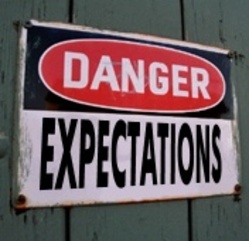I sat there listening as a director product management vented about the lack of expectations set by his executive leader. Have you ever been in this situation? Were you on the listening or venting side?
Either way, setting clear expectations is essential to those who lead products and those who lead product management and product marketing teams.
If you’re thinking the organization sets expectatons, you’re mistaken. In his post, Expectations are the Bosses Business, Wally Bock shares; “It’s your boss’s responsibility to set good expectations and then follow through.”
Whether you lead products or people or both, there are a few things you have to remember:
Set expectations early and often. to frequently I hear about product leaders who set no expectations with their teams or for their products. Do you think it’s going to happen through osmosis? Setting expectations for yourself, your team and your products is a basic principle of product management and product marketing. If you lead a team, schedule time to meet as a group (preferably out of the office) and communicate the expectations for the team. Solicit input along the way and listen often.
If you don’t let people know what to expect, they’ll create an expectation for you. Some time ago, I had a bright product manager working on my team. He came into my office visibly frustrated. When I asked what was going on, he said, “I’ve just reviewed the new product prototype from development and it’s all wrong!” I asked if he had set any specific expectations with the development team prior to handing them a set of user stories? He didn’t. He had expected development to figure out a solution to a market problem on their own. Being specific upfront eliminates frustration and hard feelings later on.
Clarification and communication. The idea of setting an expectation and not providing clarification is a recipe for failure. If you’re leading a product, stay connected with the team involved in it’s development and delivery, and ask, “We’ve discussed the expectations I have for the product, may I provide any clarification?” This will allow you to bring new artifacts and evidence forward and provide an avenue to build credibility and show value.
If you lead teams, take the time to discuss product expectations (roadmaps ), professional expectations (create and review measurements) and personal expectation (a path for growth) with each team member as often as you can. In the past, I’ve done this with Friday afternoon bull sessions, Afternoon Offsite Meetings (AOM’s) usually held at the local watering hole, brown bag lunch meetings and traditional one-on-one discussions.
Keep it consistent. While it may be a given that consistency factors into leading great products and teams, it can’t be overlooked. “Consistency may just be the very unsexy and uninspiring element to your leadership style that will help you grow your credibility and allow you to create and sustain a working atmosphere that allows your team members to prosper” shared Art Petty in his post “In praise of consistency.”
If you’re consistent in your methods, communications, actions and delivery, you won’t have to worry about the “ugly side of product management” described by Saeed Khan. I believe that product management lacks authority and power to lead and manage products due to inconsistency.
As product management and product marketing sets and manages expectations, failed products, lackluster launches, lost credibility, miscommunication and other misfires will diminish.
Feel free to add some thoughts of your own. If you like the post, please share it on Twitter and LinkedIn via: A new post “Expectations and Product Leadership” some thoughts & ideas for #prodmgmt #prodmktg & #leadership http://wp.me/pXBON-2Ik
